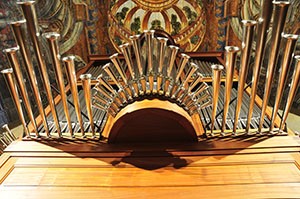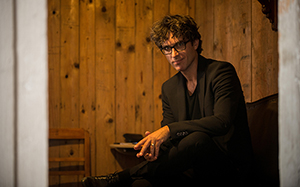
Thursday, 27 October, 9.30, p.m.,
Igreja de São João Evangelista (Colégio - Funchal)
Bach
Albrecht Koch, organ
As the organist of one of the most significant organs of the baroque period (the great Silbermann organ in the Cathedral of Freiberg), I feel especially connected to the music of Johann Sebastian Bach. This is reinforced not only by the fact that Bach and Gottfried Silberman were contemporaries, but that they had established contact in 1746. To plan a programme of works by Bach that is not simply a best of of his works is, however, a challenge. In today’s programme, I attempt to portray Bach as a tempestuous young man, and change him into the very different mature Bach. The concert opens with the Prelude and Fugue in D major. With the scale of an octave on the pedalboard at the beginning and a very virtuosic fugue, it is one of Bach’s most technically demanding organ works. It was written in around 1710 in Weimar, where Bach had found employment, after a short period as organist in Mühlhausen. The pieces clearly shows the temperamental character of the young Bach, then twenty-five years old, but already in full possession of his technical capacity as an organist – a not uninsignificant basis for his compositions. The two chorale prelused BVW 713 and 709 were probably written in 1708 and are also attributed to the Weimar period. Both pieces are mentioned in the collection by the theoretician and composer Johann Philipp Kirnberger. The Prelude and Fugue in G major probably originates from the last year in Weimar, 1717. The Prelude, marked by the style of the Italian concerto, has the indication Vivace. Bach’s autograph copy was made, however, only in 1733, probably in Leipzig, for the admission of his son Wilhelm Friedemann to the position of organist of the Silbermann organ in the Sophienkirche in Dresden. At the centre of the programme is the mature Bach, who is defined above all, almost as a summa summarum, in the last fugue of the Art of Fugue, which has come down to us incomplete. The fugue is built from three themes, of which the last quotes the name of the composer by meansofthenotesBflat–A–C–Bnatural (in German nomenclature representated by the letters B-A-C-H). The introduction of this theme coincides with the interruption of the manuscript. Carl Philipp Emanuel Bach noted, “N.B.: during the composition of this fugue, where the name BACH is used as a countertheme, the author passed away”. The manuscript appeared during the three years of Bach’s life, and it was only printed after his death. The publisher included in it the chorale Vor deinen Thron tret ich hiermit, which may also be found as no. 75 of the Leizpig Chorales. The Trio on Herr Jesu Christ, dich zu uns wend may also be found in this collection, compiled by Bach in the last years of his life. However, he made more use in it of youthgul works, some even from the Weimar period. And thus, the programme recedes chronologically to Bach’s youth and ends with one of his greatest compositions: the Passacaglia in C minor. In fact, it is a bipartite work, with a series of twenty variations on a theme, linked to a fugue on the theme of the Passacaglia. The work dates very possibly from Bach’s return to Lübeck, where he visited Buxtehude in 1705. Because of its contrapuntal complexity, it had considerable influence on similar works of the 18th and 19th centuries. It shows a tempestuous spirit whosing that already in the years of his youth he was in full possession of his compositional faculties. Able to sustain numerous interpretations, the work is today one of the best-known of Bach’s organ works and crowns the programme unmistakeably.
Albrecht Koch
Johann Sebastian Bach (1685-1750)
¬ Prelude and Fugue in D major, BWV 532
¬ Fantasia on Jesu meine Freude, BWV 713
¬ Chorale Prelude Herr Jesu Christ, dich zu uns wend, BWV 709
¬ Prelude and Fugue in G major, BWV 541
¬ Trio on Herr Jesu Christ, dich zu uns wend, BWV 655
¬ The Art of Fugue, BWV 1080
XIX – Fuga a 3 sogetti (incomplete)
¬ Chorale Prelude Vor deinen Thron tret ich hiermit, BWV 668
¬ Passaccaglia in C minor, BWV 582
Participants
|
Albrecht Koch, born in 1976 in Dresden, comes from the tradition of the Dresdner Kreuzchor. He studied sacred music and choral conucting in Leipzig, his teachers being Arvid Gast, Martin Schmeding and Morten Schuldt- Jensen Courses with personalities such as Roy Goodman, Ewald Koiman, Lars Ulrik Mortensen and Hans Fagius complemented his studies. Since 2008 Koch has been Cathedral music director and cathedral organist in Freiberg, Saxony, where he is entrusted with the organ of 1714 from Gottfried Silbermann ́s organ workshop, one of the most important instruments of the baroque period. He has met with great recognition for his discovery and revival of forgotten works from Saxony ́s music history. Since 2010 Albrecht Koch has been the president of the Gottfried Silbermann International Society. He serves as the artistic director of the renowned music festival Silbermann-Tage held every two years and of the Gottfried Silbermann International Organ Competition. He represents the city of Freiberg as an artistic director in the European Cities of Historical Organs (ECHO). Along with his musical activity at the cathedral, Albrecht Koch gives regular concerts in Germany and throughout Europe. He teaches at the University of Music in Leipzig, and is also regularly invited to be a juror at major international organ competitions and to give master classes in several countries. His other activities cover a spectrum including radio, CD and film productions. |
Notes about the organ
 Church of São João Evangelista (Colégio), Funchal
Church of São João Evangelista (Colégio), Funchal
This instrument, with 1586 sounding pipes, is situated in a religious space with certain particularities. As a church typical of those belonging to Jesuit colleges, with a broad nave and quite a gentle acoustic, the organ had to be specially conceived, especially with regard to the measurements of the pipes. Thus all the pipework of the instrument has been specifically tailored to produce a full sound, and each stop produces a timbre with an individual personality, forming part of a harmonic ensemble based more on the sound of fundamentals and less on harmonics. It was also felt to be essential to give the instrument a certain ‘latin’ sonority that would favour performance of ancient music of the Italian, Spanish and Portuguese schools of the 17th and 18th centuries.
Another aspect to be taken into consideration was the need to complement the current range of organs available locally: the new organ responds in an ideal fashion to the performance of works of periods and of technical and artistic requirements that none of the 24 historic instruments of Madeira cater adequately for. It also enhances the range of organs that constitute the island’s heritage by being present in this particular religious space, as well as by existing side by side with other historical instruments. In the decision to build it for this church, not only were the issues of acoustic, aesthetic and liturgical space taken into account, but also the presence there of an important historic instrument which is currently on the list of instruments undergoing restoration.
I Manual - Órgão Principal (C-g’’’)
Flautado aberto de 12 palmos (8’)
Flautado tapado de 12 palmos (8’)
Oitava real (4’)
Tapado de 6 palmos (4’)
Quinzena (2’)
Dezanovena e 22ª
Mistura III
Corneta IV
Trompa de batalha* (bass)
Clarim* (treble)
Fagote* (bass)
Clarineta* (treble)
II Manual - Órgão Positivo (C-g’’’)
Flautado aberto de 12 palmos (8’)
Tapado de 12 palmos (8’)
Flautado aberto de 6 palmos (4’)
Dozena (2 2/3’)
Quinzena (2’)
Dezassetena (1 3/5’)
Dezanovena (1 1/3)
Címbala III
Trompa real (8’)
Pedal (C-f’)
Tapado de 24 palmos (16’)
Bordão de 12 palmos (8’)
Flautado de 6 palmos (4’)
Contrafagote de 24 palmos (16’)
Trompa de 12 palmos (8’)
Couplers
II/I
I/Pedal
II/Pedal
* horizontal reeds
 Albrecht Koch
Albrecht Koch